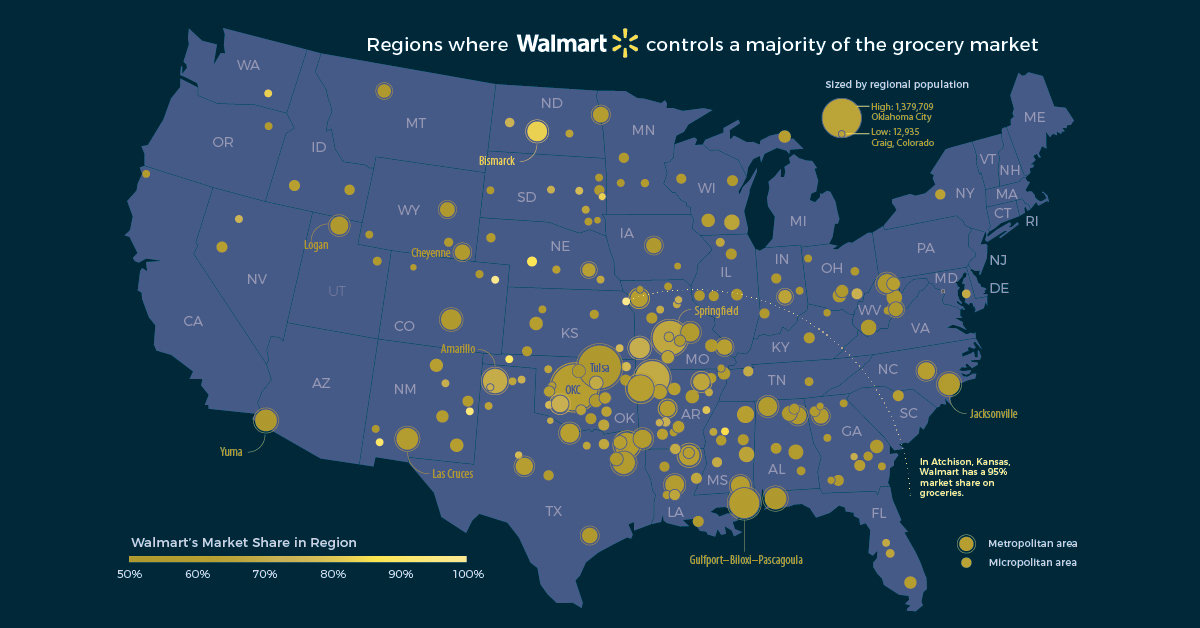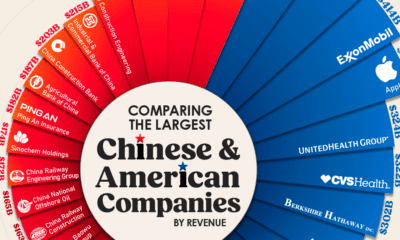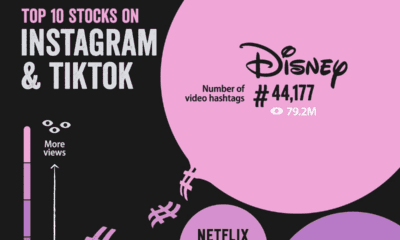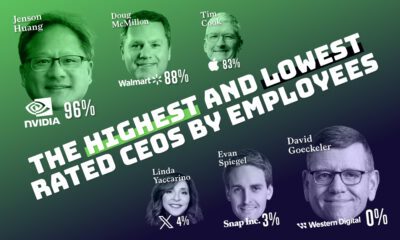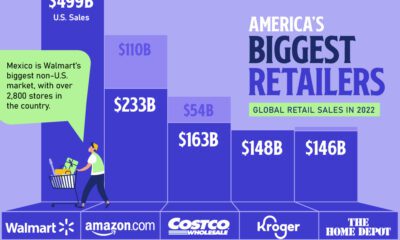Markets
Walmart’s Domination of the U.S. Grocery Market
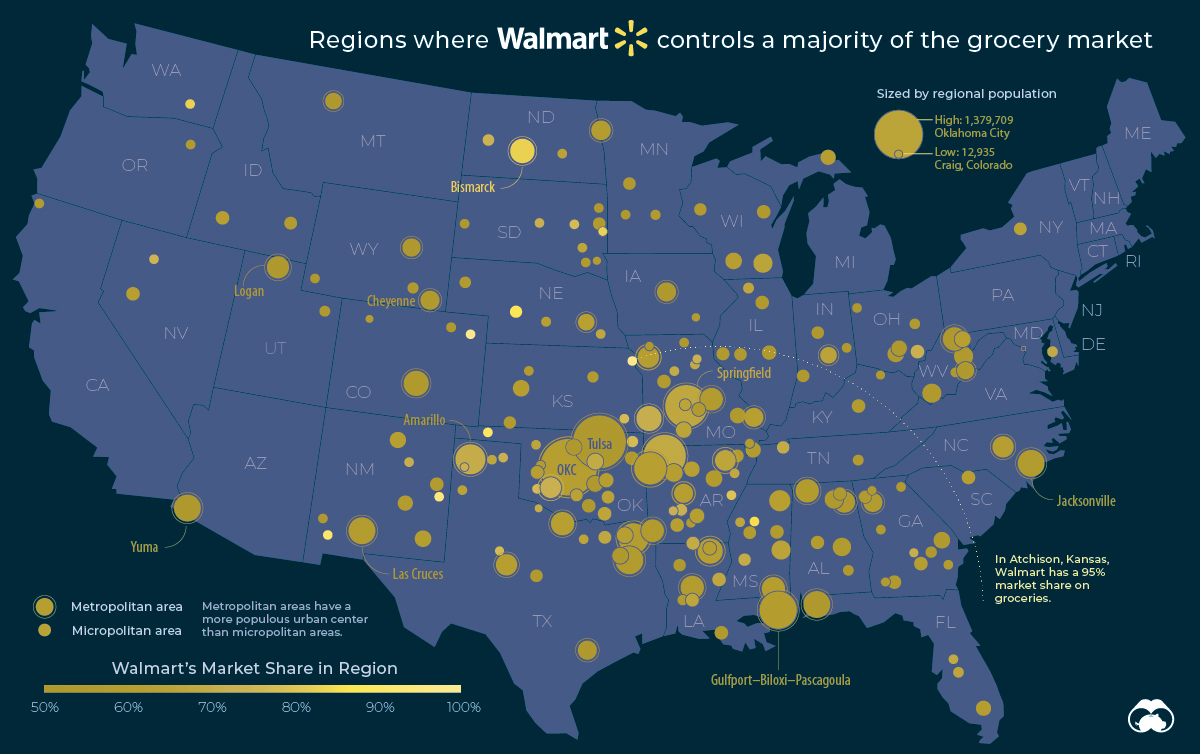
Walmart’s Domination of the U.S. Grocery Market
One wouldn’t expect the grocery department of a big box retailer to spark debate, but Walmart’s high market concentration in the grocery space is doing just that.
By now, Walmart’s rise to the top of the retail pyramid is well documented. The Supercenters that dot the American landscape have had a dramatic ripple effect on surrounding communities, often resulting in decreased competition and reduced selection for consumers. Today, in some communities, Walmart takes in a whopping $19 for every $20 spent on groceries.
Today’s map, based on a report from the Institute for Local Self-Reliance, looks at which places in America are most reliant on Walmart to put food on the table.
The Weight of Walmart
Walmart has an unprecedented amount of control over the food system, now capturing a quarter of every single dollar spent on groceries in the United States.
Walmart isn’t just a major player — in some cases it’s become the only game in town. In a few of the communities listed in the report, Walmart commands a 90% market share and higher.
Here’s a breakdown of the top 20 towns dominated by Walmart in America:
| Rank | Metro/Region | Population | Walmart Market Share |
|---|---|---|---|
| #1 | Atchison, Kansas | 16,580 | 95% |
| #2 | Portales, New Mexico | 19,730 | 95% |
| #3 | Sterling, Colorado | 22,068 | 91% |
| #4 | Deming, New Mexico | 24,699 | 90% |
| #5 | Guymon, Oklahoma | 21,385 | 90% |
| #6 | North Platte, Nebraska | 37,043 | 87% |
| #7 | Wahpeton, N.D.– Minnesota | 23,036 | 84% |
| #8 | Coffeyville, Kansas | 33,434 | 83% |
| #9 | Othello, Washington | 19,806 | 83% |
| #10 | Bismarck, North Dakota | 135,654 | 83% |
| #11 | Helena-West Helena, Arkansas | 20,176 | 80% |
| #12 | Altus, Oklahoma | 25,931 | 77% |
| #13 | Parsons, Kansas | 20,761 | 77% |
| #14 | Miami, Oklahoma | 32,260 | 77% |
| #15 | Sweetwater, Texas | 15,101 | 77% |
| #16 | Grenada, Mississippi | 21,706 | 76% |
| #17 | Huron, South Dakota | 18,082 | 75% |
| #18 | Greensburg, Indiana | 26,711 | 74% |
| #19 | Clarksdale, Mississippi | 25,085 | 74% |
| #20 | Dumas, Texas | 22,485 | 74% |
While it’s more likely for a small town to become dominated by a single grocer, Walmart’s clout isn’t exclusive to rural America. Even in Springfield, Missouri — with a regional population of half a million people — the big box retailer still boasts a sizable market share of 66%.
Super Market Concentration
Under guidelines established by the Justice Department’s Antitrust Division, markets in which one corporation captures more than 50% of revenue are defined as “highly concentrated.” Walmart’s market share meets or exceeds this measure in 43 metropolitan areas and 160 smaller markets around the United States.
In some states, this trend is even more pronounced. In Oklahoma, for example, 86% of the state’s population lives in a region where Walmart has the majority market share in the grocery sector. In Arkansas — the home state of the megaretailer — half the population lives in this “highly concentrated” grocery market situation.
This degree of market concentration means that a retailer could cut certain products or manipulate prices without fear of losing customers. Worse yet, a company could close up shop and leave thousands of people without adequate grocery access.
An Interesting Caveat
There is a flip side to this story, however.
Walmart has shown a willingness to expand their grocery business to areas that were considered “food deserts” (i.e. low-income areas without easy access to a supermarket).
In a 2011 initiative, the retailer committed to open or expand 1,500 supermarkets across America to help give more people access to fresh food.
With the ground game clearly won, America’s largest grocer is now focused on dominating the next frontier of the grocery market – delivery. Stiff competition from companies like Amazon and Instacart will keep Walmart’s online market concentration in check for the time being.
Maps
Mapped: The 10 U.S. States With the Lowest Real GDP Growth
In this graphic, we show where real GDP lagged the most across America in 2023 as high interest rates weighed on state economies.

The Top 10 U.S. States, by Lowest Real GDP Growth
This was originally posted on our Voronoi app. Download the app for free on iOS or Android and discover incredible data-driven charts from a variety of trusted sources.
While the U.S. economy defied expectations in 2023, posting 2.5% in real GDP growth, several states lagged behind.
Last year, oil-producing states led the pack in terms of real GDP growth across America, while the lowest growth was seen in states that were more sensitive to the impact of high interest rates, particularly due to slowdowns in the manufacturing and finance sectors.
This graphic shows the 10 states with the least robust real GDP growth in 2023, based on data from the Bureau of Economic Analysis.
Weakest State Economies in 2023
Below, we show the states with the slowest economic activity in inflation-adjusted terms, using chained 2017 dollars:
| Rank | State | Real GDP Growth 2023 YoY | Real GDP 2023 |
|---|---|---|---|
| 1 | Delaware | -1.2% | $74B |
| 2 | Wisconsin | +0.2% | $337B |
| 3 | New York | +0.7% | $1.8T |
| 4 | Missississippi | +0.7% | $115B |
| 5 | Georgia | +0.8% | $661B |
| 6 | Minnesota | +1.2% | $384B |
| 7 | New Hampshire | +1.2% | $91B |
| 8 | Ohio | +1.2% | $698B |
| 9 | Iowa | +1.3% | $200B |
| 10 | Illinois | +1.3% | $876B |
| U.S. | +2.5% | $22.4T |
Delaware witnessed the slowest growth in the country, with real GDP growth of -1.2% over the year as a sluggish finance and insurance sector dampened the state’s economy.
Like Delaware, the Midwestern state of Wisconsin also experienced declines across the finance and insurance sector, in addition to steep drops in the agriculture and manufacturing industries.
America’s third-biggest economy, New York, grew just 0.7% in 2023, falling far below the U.S. average. High interest rates took a toll on key sectors, with notable slowdowns in the construction and manufacturing sectors. In addition, falling home prices and a weaker job market contributed to slower economic growth.
Meanwhile, Georgia experienced the fifth-lowest real GDP growth rate. In March 2024, Rivian paused plans to build a $5 billion EV factory in Georgia, which was set to be one of the biggest economic development initiatives in the state in history.
These delays are likely to exacerbate setbacks for the state, however, both Kia and Hyundai have made significant investments in the EV industry, which could help boost Georgia’s manufacturing sector looking ahead.
-

 Personal Finance1 week ago
Personal Finance1 week agoVisualizing the Tax Burden of Every U.S. State
-

 Misc6 days ago
Misc6 days agoVisualized: Aircraft Carriers by Country
-

 Culture7 days ago
Culture7 days agoHow Popular Snack Brand Logos Have Changed
-

 Mining1 week ago
Mining1 week agoVisualizing Copper Production by Country in 2023
-

 Misc1 week ago
Misc1 week agoCharted: How Americans Feel About Federal Government Agencies
-

 Healthcare1 week ago
Healthcare1 week agoWhich Countries Have the Highest Infant Mortality Rates?
-

 Demographics1 week ago
Demographics1 week agoMapped: U.S. Immigrants by Region
-

 Maps1 week ago
Maps1 week agoMapped: Southeast Asia’s GDP Per Capita, by Country

